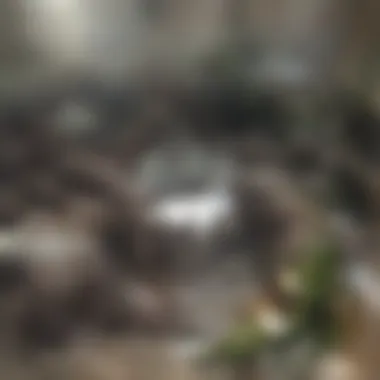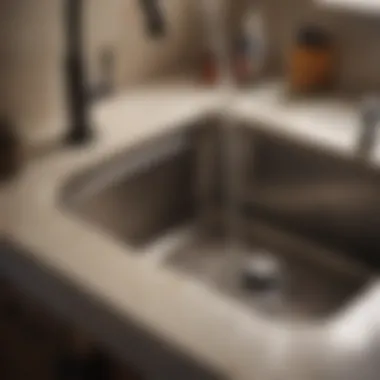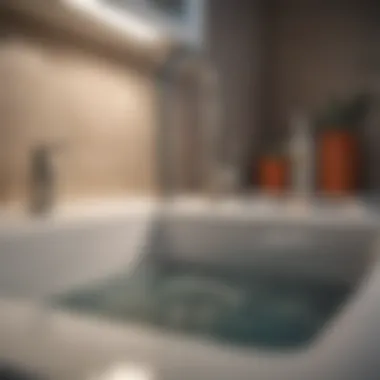Effective Solutions for Unclogging Your Sink Drain


Intro
Clogged drains are a common issue in households. A blockage in a sink drain can disrupt daily routines and create frustrating situations. Understanding how to fix a clogged drain effectively can save time and money for homeowners. Knowing the causes, tools, and methods available makes resolving this problem easier. This article delves into the myriad aspects of unclogging sink drains, including prevention and when to call a professional.
Understanding the Causes of Clogs
Clogs can be caused by various factors. Recognizing these is crucial to addressing the issue effectively:
- Food debris: Small bits of food can accumulate over time, creating a blockage.
- Grease buildup: Cooking oils and fats can solidify in pipes, causing clogs.
- Hair: Hair strands can easily tangle around drain components, leading to blockages.
- Foreign objects: Items inadvertently dropped into the sink can create instant blockages.
Being aware of these causes helps in developing strategies to prevent future clogs.
Tools Needed
To fix a clogged sink drain, specific tools can make the process smoother. Here are some essential tools:
- Plunger: Useful for clearing minor to moderate clogs.
- Drain snake: An effective tool to reach deeper blockages.
- Baking soda and vinegar: Natural cleaning agents that can break down light clogs.
- Buckets: For catching any water that may spill during the process.
Having these items at hand can greatly enhance the unclogging experience.
Methods to Unclog a Drain
There are several methods you can use to clear a clogged drain:
Using a Plunger
- Ensure there is enough water in the sink to cover the plunger.
- Place the plunger over the drain, creating a strong seal.
- Push down and pull up quickly for about 20 seconds.
This should create enough pressure to dislodge the clog.
Employing Baking Soda and Vinegar
- Pour half a cup of baking soda down the drain.
- Follow with half a cup of vinegar.
- After a few minutes, flush with boiling water.
This mixture can help dissolve minor clogs and deodorize the drain.
Using a Drain Snake
- Insert the drain snake into the clog.
- Rotate the handle to break up the clog.
- Pull out the snake and debris it collects.
The drain snake is particularly useful for deeper and more stubborn clogs.
Tip: Always run hot water for a few minutes after using any unclogging method to help clear the pipes.
Prevention Tips
Preventive measures are essential in avoiding future blockages. Consider these strategies:
- Avoid pouring grease down the sink. Instead, use a container for disposal.
- Use drain guards to catch hair and food particles.
- Regularly flush the drain with hot water.
Taking these simple steps can help maintain clear and functioning sink drains.
When to Seek Professional Help
Occasionally, clogs may be beyond the capabilities of DIY methods. Contact a professional plumber when:
- Clogs persist after multiple attempts to clear them.
- There are signs of leaks or water damage around the sink.
- The problem affects multiple drains in the home.


Professional services can quickly diagnose and resolve persistent drainage issues.
End
Fixing a clogged sink drain can be straightforward with the right knowledge and tools. By understanding the causes and employing effective methods and preventive measures, homeowners can maintain their plumbing efficiently. When problems do occur, knowing when to call a professional can save time and hassle. This proactive approach not only ensures clear drains but also contributes to a more functional living space.
Prelims to Clogged Drains
Clogged drains in sinks can create significant inconveniences for homeowners. Understanding the fundamentals of this issue is crucial for effective maintenance and prevention. Clogs not only disrupt daily activities like washing dishes, but they can also lead to more severe plumbing problems and costly repairs. Therefore, addressing clogged drains efficiently becomes essential for maintaining a functional household.
Understanding the Mechanics
The mechanics of drain systems are straightforward yet complex. Water and waste flow through a network of pipes that can easily become obstructed. When water is unable to move freely due to a blockage, pressure builds in the system, leading to potential damage.
This understanding empowers homeowners to recognize the importance of timely intervention. Regularly monitoring drainage efficiency helps catch potential clogs before they escalate.
Common Causes of Clogs
Many factors contribute to clogs in sink drains. Recognizing these can prevent future issues.
- Food Particles: Small remnants of food can accumulate, especially in kitchen sinks, leading to stubborn blockages.
- Grease Build-Up: Cooking oils and fats can solidify and stick to pipe walls, creating blockages over time.
- Hair: In bathroom sinks, hair can trap soap and other debris, making it a common cause for clogs.
- Foreign Objects: Items accidentally dropped down the drain can lead to unexpected issues.
By understanding these causes, homeowners can take proactive steps to maintain their drains, ensuring smoother operations.
Identifying Signs of a Clog
Recognizing the early symptoms of a clog in the sink can save you time and money. Timely intervention is critical to avoid more severe plumbing issues later. Homeowners should be familiar with the signals that indicate a blockage. A simple and attentive approach can help in identifying these signs.
Slow Draining Water
One of the most common initial signs of a clog is slow draining water. When you notice that the water does not flow smoothly down the drain, it indicates a possible blockage. This can manifest when doing dishes or washing hands. Ideally, water should not pool at the bottom of the sink for a prolonged period. If it does, the drain is likely obstructed.
Slow drainage happens when debris accumulates in pipes. This debris can include food particles, soap scum, or hair. A slow drain requires your attention. Allowing this problem to persist can lead to complete blockage. Check the sink regularly to notice changes in how quickly water drains.
Unpleasant Odors
An unpleasant smell emanating from the sink is another sign of a likely clog. Organic material trapped in the drain can begin to decompose, resulting in a foul odor. Sometimes, this issue may not be visible but can be very noticeable through the smell. The odor may have a musty or sewage-like quality. Regular, thorough cleaning can help minimize this type of issue, but if the smells persist, it is a clear sign of a buildup.
Checking for odors can guide you in determining if it is time to take action. Proactive care of the drain can prevent this buildup of waste.
Gurgling Sounds
Gurgling sounds coming from your sink can be quite alarming. However, these sounds are an essential signal that something is wrong. When air tries to escape through a blocked pipe, it creates a gurgling noise. This means your drainage system is having difficulties. Pay attention when you hear these noises during or after water flow. The gurgling indicates that water may be struggling to pass through due to a blockage.
As soon as you notice gurgling, consider taking action to prevent a more severe clog. Investigating promptly can help avoid further complications. This issue can become disruptive in your household, affecting daily tasks. It is best to respond to this sign quickly to maintain proper drainage functionality.
Essential Tools for Unclogging
Unclogging a sink drain effectively requires the right tools. Each tool has its own advantages, catering to different types of clogs and conditions. Understanding these essential tools is vital for anyone who wants to tackle clogs independently, whether due to convenience or cost-effectiveness. Having the correct tools can not only save time but also prevent potential damage to the plumbing system.
Plunger
The plunger is a basic yet invaluable tool in unclogging a sink drain. It operates on the principle of creating pressure to dislodge the blockage. A cup plunger, specifically, is designed for sinks, while a flange plunger is more suited for toilets. When using a plunger, it is important to ensure that there is enough water in the sink to cover its suction cup. This water facilitates a better seal and enhances the effectiveness of the plunger. By pushing down forcefully and then pulling up quickly, the operator can potentially remove minor blockages like food particles or hair without resorting to chemicals.
Drain Snake
A drain snake, or auger, is a specialized tool designed to reach deeper into plumbing systems. It typically consists of a long, flexible metal cable with a coiled end. The drain snake can effectively break apart or retrieve items causing the clog. This is particularly useful for stubborn clogs that a plunger cannot dislodge, such as more substantial debris or invasive tree roots. Using the drain snake requires some technique, including inserting it into the drain until resistance is felt, then turning the handle to either break through the clog or latch onto it for removal.
Baking Soda and Vinegar


Baking soda and vinegar are natural alternatives for unclogging drains. This combination is both eco-friendly and effective for minor clogs. The chemical reaction between baking soda and vinegar generates carbon dioxide, which can help break down some types of blockages. To use this method, pour half a cup of baking soda down the drain followed by half a cup of vinegar. Cover the drain with a cloth or stopper to keep the reaction contained for about 30 minutes before flushing with hot water. This method is ideal for organic material clogs but might not always suffice for tougher blockages.
Wet/Dry Vacuum
A wet/dry vacuum, often referred to as a shop vacuum, is another powerful tool. It can be used to remove liquids and debris from drain systems, proving especially useful for larger clogs. By creating suction, the vacuum can pull out blockages that are otherwise inaccessible. Proper setup involves selecting the wet setting, attaching the right nozzle, and securing a snug fit to the drain before turning it on. The powerful suction can effectively clear out built-up debris, especially if used promptly after a clog forms.
Procedure to Unclog a Sink
Unclogging a sink is a vital procedure for homeowners. When water doesn't drain properly, it can lead to a host of inconveniences. Knowing the procedure allows you to address the problem efficiently. It saves you money and time while maintaining a functional living space.
Several methods exist for unclogging a sink, each with different requirements and effectiveness. Understanding how to apply each technique ensures that you can select the right one for your specific situation. A thorough approach reduces the likelihood of recurrence. Now, let's explore the various methods.
Using a Plunger
A plunger is one of the simplest tools available for a clogged sink. It works by creating a vacuum that dislodges debris. Start by ensuring there is enough water in the sink to cover the plunger’s cup.
- Place the plunger over the drain.
- Ensure a good seal is formed.
- Push down forcefully, and then pull up quickly.
- Repeat this several times to generate suction.
This method is effective for minor clogs caused by food particles or soap buildup. If successful, you will notice the water draining away more easily.
Employing a Drain Snake
A drain snake can reach deeper clogs. This tool is a flexible metal coil that can extend into the pipe. Here’s how to use it.
- Remove the sink stopper if applicable.
- Insert the snake into the drain until you feel resistance.
- Rotate the handle to latch onto the obstruction.
- Pull it out carefully.
Drain snakes can eliminate more persistent blockages. This method is particularly useful for hair clogs in bathroom sinks.
Chemical Drain Cleaners
Chemical drain cleaners offer an alternative for more serious clogs. These substances use harsh chemicals to dissolve obstruction. It’s essential to follow the instructions carefully.
- Choose a chemical cleaner suitable for your type of drain.
- Pour the recommended amount down the drain.
- Allow time for the cleaner to work, usually about 30 minutes.
- Flush with hot water.
While effective, these chemicals can be harmful to plumbing over time. Use them as a last resort and always prioritize safety.
Applying Baking Soda and Vinegar
For a more natural solution, consider using baking soda and vinegar. This method relies on a chemical reaction to help break down clogs.
- Pour half a cup of baking soda into the drain.
- Follow this with half a cup of vinegar.
- Allow to sit for about 30 minutes.
- Rinse with boiling water.
This technique is eco-friendly and works well for mild clogs. It is also an excellent preventative step. Regular use can keep drains clear without the need for harsh chemicals.
Each of these methods can be effective if applied appropriately. Evaluate the severity of the clog to choose the best approach.
When to Call a Professional
Addressing a clogged sink can often be a manageable task for homeowners. However, there are specific situations where seeking help from a plumbing professional is the wiser option. Understanding when to involve an expert can save time and prevent further complications.
Repeated Clogs
If your sink clogging happens frequently despite your best efforts to resolve it, this raises a red flag. Repeated clogs indicate an underlying issue that basic methods like plunging or using a drain snake cannot fix. The recurring nature of the problem suggests deeper issues within the plumbing, such as:
- Tree roots infiltrating the pipes.
- Grease buildup in older pipes.
- Pipe corrosion or physical damage.
Ignoring these signs can exacerbate the problem, leading to expensive repairs. In such cases, a professional plumber can perform a thorough inspection and provide targeted solutions.
Visible Damage


Another telltale sign that it's time to call a professional is when you notice visible damage around plumbing fixtures. Signs may include:
- Water stains on walls or ceilings.
- Cracks in the walls near plumbing lines.
- Dripping or pooling water beneath the sink.
Visible damage often suggests leaks or structural issues that require immediate attention. Left unchecked, these problems can lead to mold growth and significant water damage. A professional can evaluate the situation to mitigate any potential hazards and restore your plumbing to a safe and functional state.
Complex Systems
Not all plumbing setups are straightforward. In homes with complex plumbing systems, including multiple interconnected drains or appliances tied to the same drain, tackling clogs can become quite challenging. If the clog appears to affect multiple areas simultaneously, this could signal:
- A blockage in the main sewer line.
- Improper installation of plumbing fixtures.
- Siphoning issues between fixtures.
Handling these systems requires knowledge and skills beyond DIY methods. A qualified plumber can employ specialized equipment and techniques, such as a camera inspection, to diagnose and address the clog effectively.
Remember, while DIY solutions can be effective, certain situations demand professional intervention to preserve the integrity of your plumbing system.
Preventative Measures
Preventative measures play a crucial role in maintaining clear and functional sink drains. By proactively addressing the factors that lead to clogging, homeowners can save time, money, and effort in responding to these situations. Clogs often arise from the gradual accumulation of debris, which can be mitigated through regular upkeep and responsible usage. Understanding these preventative strategies is essential in sustaining the hygiene and performance of plumbing systems.
Regular Maintenance
Conducting regular maintenance is vital in ensuring your sink drains remain unclogged over time. This involves periodic inspections and cleanings. Homeowners should consider the following tasks:
- Flushing: Pouring boiling water down the drain can help dissolve grease and soap residues that may contribute to blockages.
- Scheduled Cleanings: Establish a cleaning routine—weekly or monthly—to prevent buildup. This includes using a mixture of baking soda and vinegar as a natural cleaner.
- Testing Drains: Observe how quickly water drains. If you notice any slow down, take action before it worsens.
Implementing a maintenance schedule can significantly thwart the development of clogs, ensuring smoother operation.
Avoiding Certain Materials
Awareness of what materials are introduced into the sink is another key aspect of avoiding clogs. Some items should never be disposed of in this manner. Key points include:
- Greases and Fats: These substances congeal as they cool, causing blockages rather quickly.
- Food Particles: Small leftovers can accumulate and lead to clogs. Use a compost or trash bin instead.
- Foreign Objects: Items like cotton swabs, hair, and small toys can create significant issues. Use a wastebasket to dispose of these properly.
Making a conscious effort to avoid these materials can have a profound impact on maintaining a clear drainage system.
Utilizing Drain Screens
Drain screens are effective in preventing clogs while allowing water to flow freely. Incorporating drain screens or strainers is simple yet beneficial. Here are some advantages:
- Debris Collection: They effectively capture larger particles, such as food scraps and hair, that can impede drainage.
- Easy Maintenance: Regularly emptying the screen is simple to do and can be part of your maintenance routine.
- Cost-Effective: These screens are inexpensive and serve as a long-term investment in preventing plumbing issues.
Using drain screens is a straightforward and efficient way to safeguard against obstructive materials entering your plumbing system.
By implementing these preventative measures, you can significantly reduce the likelihood of clogged drains and maintain the efficiency of your plumbing for longer periods.
Finale
In this article, we have explored the complexities surrounding clogged drains in sinks. Understanding how clogs form, the tools necessary for their removal, and the proper techniques is essential for any homeowner. We discussed various methods to diagnose and remedy drain issues and highlighted when professional help is warranted.
Summarizing Key Points
To encapsulate the critical aspects of this guide:
- Understanding Clogs: Knowledge of common causes, like food waste and hair, is vital.
- Essential Tools: Basic implements such as a plunger, drain snake, and baking soda can effectively unclog sinks.
- Unclogging Procedures: Step-by-step methods give clear direction on tackling blockages with confidence.
- Professional Help: Recognizing when to call a plumber prevents further damage and more expensive repairs.
- Preventative Measures: Regular maintenance and mindful usage can significantly reduce the frequency of blockages.
In summary, being informed about these key areas equips homeowners with the necessary tools and strategies to handle clogged drains effectively.
Encouraging Proactive Care
Taking proactive steps in plumbing maintenance is crucial. One must not wait for visible signs of a clog before acting.
- Scheduling Regular Inspections: Consider having a plumber inspect the plumbing system annually to catch issues early.
- Proper Disposal of Waste: Avoid flushing inappropriate materials; dispose of food waste correctly.
- Routine Cleaning: Simple acts like running hot water down the drain after heavy usage helps prevent buildup.
Investing time in these preventative measures not only saves money but also promotes a healthier home environment. By being proactive, homeowners can ensure that their plumbing systems function smoothly and efficiently.



